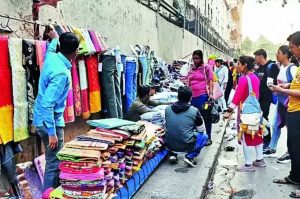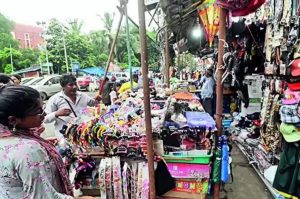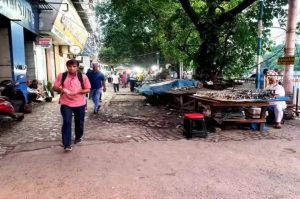Street Dwellers Resist Kolkata Pavement Eviction: Rafi Ahmed Kidwai Road, one of central Kolkata’s most important arteries, recently turned into a site of confrontation between civic authorities and residents when an anti-encroachment drive by the Kolkata Municipal Corporation (KMC) and police was abruptly halted. The operation, aimed at clearing shanties and reclaiming pavements near Prabhu Jishu Girja, saw about 35 structures pulled down before angry locals intervened.

The confrontation lasted four hours. Protesters argued that enforcement was being applied selectively—while shanty dwellers were displaced, hawkers with makeshift stalls and carts remained untouched. Civic trucks were blocked, slogans were raised, and by dusk, officials had withdrawn. What was meant to be a clean-up became a symbol of the messy balance between legality, survival, and politics in Kolkata’s public spaces.
Street Dwellers Resist Kolkata Pavement Eviction: Life on a Congested Pavement
For pedestrians, Rafi Ahmed Kidwai Road has become nearly impassable. With hawkers and dwellers occupying pavements, foot traffic spills into the carriageway, raising risks for schoolchildren, office-goers, and the elderly. Residents also complain of fire hazards due to gas cylinders used in makeshift food stalls and allege that ambulances often struggle to pass through the bottlenecks.


“I’ve seen three ambulances stuck in traffic because of these blockages,” said a local resident. “This is not just about convenience—it’s about lives.”
For those living in the shanties, however, the pavement is not simply a trading space but home. “If you clear us and spare hawkers, you’re not enforcing law—you’re picking and choosing,” said one protester.
The Legal Backdrop: Rights Versus Regulation
The confrontation highlights the complexities of implementing the Street Vendors (Protection of Livelihood and Regulation of Street Vending) Act, 2014. The Act legitimizes vending as an economic activity but sets conditions:
- Two-thirds of pavement space must remain free for pedestrian use.
- Town Vending Committees (TVCs) must regulate licenses and designate vending zones.
- Evictions should be accompanied by rehabilitation measures.
You can read the full Act and its guidelines here: Street Vendors Act, 2014 – PRS India.


In Kolkata, enforcement often falters because TVCs are either not fully functional or lack teeth. This leads to episodic drives, quickly reversed when hawkers and dwellers reoccupy vacated spots—sometimes within hours.
Historical Echoes: Operation Sunshine and Its Lessons
Kolkata has been here before. In the mid-1990s, Operation Sunshine sought to clear hawkers from major roads. Pavements were freed temporarily, but political patronage, lack of rehabilitation, and weak follow-up saw encroachments return.
The courts have weighed in multiple times. A Calcutta High Court ruling in 1996 compared the unchecked growth of encroachment to “cancer,” urging civic bodies to protect pedestrian rights. Yet, three decades later, the same stretches remain contested.
The Political Equation
Urban encroachment in Kolkata cannot be separated from politics. Hawker unions represent a powerful constituency, often mobilized during elections. Shanty dwellers, too, form vote banks whose grievances echo loudly during campaigns.
Thus, every enforcement drive is politically sensitive. Selective application—whether perceived or real—fuels accusations of bias. On Rafi Ahmed Kidwai Road, protesters’ anger stemmed not only from displacement but also from the impression that they were targeted while hawkers were spared, highlighting the deep-rooted political calculus behind civic action.
Public Safety and Urban Planning
Urban researchers point out that Kolkata’s problems are not unique. Many global cities have grappled with balancing informal economies with urban planning. For instance, Bangkok experimented with designated night markets, while Bogotá created structured vending zones with sanitation and security facilities.
Organizations such as the Institute for Transportation and Development Policy (ITDP) stress pedestrian-first urban design. When streets are designed for people, not just cars, space for informal vendors can be integrated safely.
Kolkata’s own experiments, like the Russel Street plastic-free food hub, prove regulation and livelihood can coexist when planning is holistic. Vendors there follow hygiene norms, wear uniforms, and operate within a structured layout—demonstrating that enforcement need not equal eradication.
Why Drives Fail
- Temporary Nature – Evictions are often one-off, with no long-term plan.
- No Rehabilitation – Shanty dwellers have nowhere to go, and hawkers rely on daily earnings.
- Political Resistance – Patronage shields many encroachers.
- Economic Dependence – Both hawkers and residents represent the city’s vast informal economy.
- Institutional Weakness – TVCs and civic enforcement lack resources for sustained oversight.
Stakeholder Voices
- Residents: Demand pavements for safe walking and reduced congestion.
- Street Dwellers: See their removal as an attack on survival, especially when hawkers remain untouched.
- Hawkers: Argue they provide essential services and affordable goods.
- Civic Officials: Admit drives are often “futile” without consistent follow-up or rehabilitation measures.
- Urban Planners: Advocate for long-term integration, not eviction, using zoning and urban design tools.
What Lies Ahead
Councillor Sana Ahmed has assured that hawkers too will face removal, and the drive will continue. But unless KMC pairs enforcement with a comprehensive vending policy, history suggests pavements will be reoccupied, and another confrontation will soon unfold.
A sustainable solution would involve:
- Regularized vending zones.
- Affordable housing or shelter options for street dwellers.
- Transparent enforcement monitored by independent committees.
- Public awareness campaigns about pedestrian rights.
A City at a Crossroads
Rafi Ahmed Kidwai Road now stands as a symbol of Kolkata’s urban contradictions:
- A civic body tasked with regulation but constrained by politics.
- Communities fighting for survival clashing with residents demanding safety.
- Courts issuing orders that rarely translate into lasting change.
For Kolkata to move forward, the question is no longer just about one pavement—it’s about whether the city can reconcile livelihood with livability, rights with responsibilities, and law with compassion.
Until then, the pavements of Rafi Ahmed Kidwai Road will remain a battleground where the everyday struggle for survival collides with the vision of a city that works for all.
Also read: Home | Channel 6 Network – Latest News, Breaking Updates: Politics, Business, Tech & More

